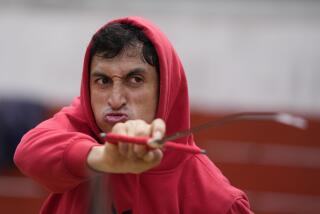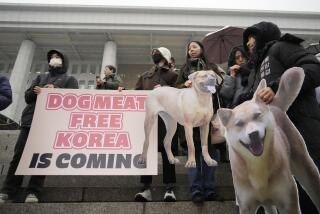Afghans unapologetically cheer on dogfights
- Share via
Reporting from Kabul, Afghanistan — Meyaan Ahamad dips his head into the shed where his prized fighting dog barks ferociously at the end of a chain. The dog, a Kuchi breed, has weightlifter shoulders, a massive head, the heft of a black bear and the growl of a cougar.
If Michael Vick, the American quarterback convicted of participating in an illegal dogfighting operation, were from Afghanistan, he’d probably be a national hero. In this country, canine bouts — literally “dog wars” in Dari — are keenly followed even by celebrities and government ministers.
It’s not about the money, said Ahamad, whose family has bred fighters for generations. It’s about knowing you’ve got the biggest, baddest dog around. “You get respect,” he said.
Maybe. But the money isn’t too shabby either. Winning dogs fetch more than $20,000 and bets worth hundreds of thousands of dollars are made during big fights. “Some people arrive in a Lexus and end up losing it betting,” Ahamad said. “They go home bravely, but once inside, they cry.”
Kuchis, which take their name from a nomadic tribe, can weigh as much as 175 pounds, their backs as tall as 3 feet. Bred to guard livestock and kill wolves, they’re said to be naturally aggressive.
“Iranian and Pakistani dogs are all right,” dog owner Abdul Qadir said. “But Kuchis are tougher, just like the Afghan people.”
Technically, dogfighting is illegal here. But there’s little enforcement given its popularity and how much money and how many powerful people are involved. (The champion fighter in Kabul, named Marshal, is owned by the nation’s first vice president, Mohammed Fahim.) A stadium in northern Kabul seats 1,500, with smaller venues found in most neighborhoods.
“Afghans are from a warrior culture,” said Marnie Gustavson, an animal lover, Kuchi owner and executive director of Parsa, a civic group helping underprivileged Afghans. “They fight everything — birds, camels, kites. Why would dogs be any different?”
Before fights, Kuchis are taken for long walks on steep mountain paths and fed a special diet believed to enhance their strength and ferocity, owners said, including eggs and sheep’s feet.
Most matches take place during the cooler months, October to February, when the dogs are more energetic and their wounds are said to heal faster. Fights can last five to 90 minutes. “It can take two weeks to get them healed and their energy back after a fight,” Ahamad said, “and a lot of sheep feet.”
Afghans remain unapologetic about this blood sport, contending that the Kuchis are treated better than family and fighting is in their nature. Matches are also more humane than in other countries, they say, because they’re halted before the loser is killed, with fights often stopped when the loser bares its teeth.
“I used to beat my dogs to make them tougher,” said Ahamad, sporting a neatly trimmed beard and a green vest over his traditional shalwar kameez. “But they’d get so scared. They’d pee when they saw me, so I stopped.”
Animal welfare is a rather foreign concept in Afghanistan. There’s little history of keeping pets in this country, which traditionally has had barely enough to feed itself, with animals expected to plow, guard or otherwise earn their keep. And many Muslims consider dogs unclean.
Three decades of war has made brutality part of life’s daily fabric, analysts said, not to mention the residual effect of years living under the Taliban, which killed dogs and beat their owners (although dog owners said betting on fights continued in secret).
In February, the Taliban detonated bombs twice in Kandahar in and around dogfights, killing 25 people.
“Afghans are angry,” Gustavson said. “It’s a culture of violence. And someone who beats their dog probably beats their wife.”
The ones most concerned with animal welfare here tend to be foreigners, who generally tread lightly.
“We never raise the issue or tell Afghans not to have dogfights,” said Pen Farthing, a former British soldier who started Nowzad Dogs, an animal rescue charity operating in Afghanistan, after serving there for seven years. “We’d lose all credibility. Instead, we focus on helping strays.”
Farthing started the group, which keeps about 60 dogs at a secret location to avoid Taliban attacks, after breaking up a dogfight in Helmand province and adopting one of the fighters. He has recruited a few Afghan boys to help him feed those awaiting adoption, hoping to improve attitudes among the next generation.
Not all Afghans are fans of dogfights.
“It’s not instinct that makes them fight and bleed; they’re trained that way,” said Ramin Raha, 25, a music student. “Not that I necessarily blame their owners. With no human rights in Afghanistan, how can you expect animal rights?”
Ahamad and Qadir said they each keep two dogs, their best prospect and a second in case the first one loses. After a loss, dogs are often abandoned to avoid the expense of feeding them. Owners say it’s a blessing because they’re finally free. Animal lovers say it sentences them to a life of subsistence, disease and fighting.
Either way, Ahamad sees little need to change an age-old system he’s passionate about.
“Dogfighting in Afghanistan is thousands of years old,” he said. “And it will continue for thousands more.”
Magnier was recently on assignment in Kabul.More to Read
Sign up for Essential California
The most important California stories and recommendations in your inbox every morning.
You may occasionally receive promotional content from the Los Angeles Times.










